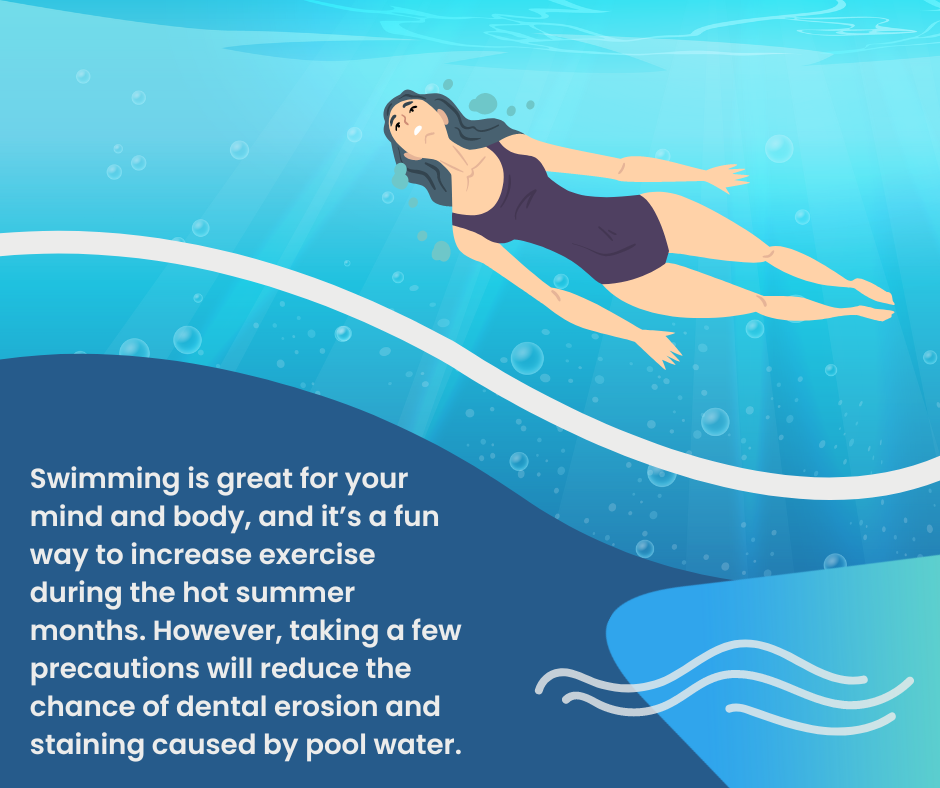Swimming is a good way to beat the heat, but did you know it can have an impact on your dental health? It’s true!
In recent years, it has become clear that there is a link between chlorinated pool water and dental conditions referred to as swimmer's erosion, swimmer’s calculus, or swimmer’s mouth. When left untreated, these conditions can cause unpleasant effects like enamel loss, tooth sensitivity, transparency around edges of teeth, yellow or brown staining, and tartar buildup. Fortunately, knowledge is power, and we are here to give you details about how you can avoid having chlorinated chompers.
Who Should Be Worried?
Competitive swimmers—defined as people who swim at least two hours each day five days a week—need to be especially mindful of harm caused by pool water. According to a study from the University of Western Australia, children who swim competitively have a significant increase in dental staining as compared to their peers.
On the other hand, if you are only an occasional swimmer, it is unlikely that you need to worry much about the effects on your teeth unless they are already compromised.
People who normally swim in a saltwater pool also have less to worry about. This type of pool still contains chlorine, but not as much as traditional pool water. Aside from being better for your oral health, saltwater pools have the added bonus of being milder for your eyes, skin, and hair.
Everyone, regardless of how much or where they swim, should avoid pools that aren’t regularly tested. Swimmer’s dental conditions will worsen from badly maintained pools with improper chlorine and pH levels.
 graphic of woman swimming with excerpt text from the article
graphic of woman swimming with excerpt text from the articlePreventing Damage
So, does this mean that you can no longer enjoy a refreshing swim in the pool if you want healthy teeth? Not at all! Swimming is great for your mind and body, and it’s a fun way to increase exercise during the hot summer months. However, taking a few precautions will reduce the chance of dental erosion and staining caused by pool water. Here are some tips to keep your teeth in great shape:
- Try to keep your mouth closed while you swim.
- Brush your teeth before getting in the water so that chemicals don’t stick to plaque.
- If you own a chlorinated swimming pool, test the water weekly and keep the pH levels between 7.2 and 7.6 to protect enamel while still maintaining the bacteria-killing effects of the chlorine.
- If using a public pool, there are two main things you can do to check for proper maintenance:
- Ask questions about the facility’s pool maintenance procedures. If they aren’t testing the water regularly, try to swim in a different pool.
- Look at structures attached to the pool such as ladders. If they show signs of erosion, chances are good that the water is not maintained properly and will do the same to your teeth.
- Go for a relaxing dip in the water instead of swimming, and that way you can keep your head out of the water entirely.
- There is some evidence that chewing xylitol gum three times a day can lower the risk of erosion.
- If you swim six hours or more a week, tell your dentist and make sure to keep up on your recommended maintenance cleanings so any problems are caught early.
- One option that the dentist may suggest is a special fluoride treatment for added enamel protection.
Many people are still unaware of the effect swimming can have on teeth, so share this article with a friend to save their smile this summer!